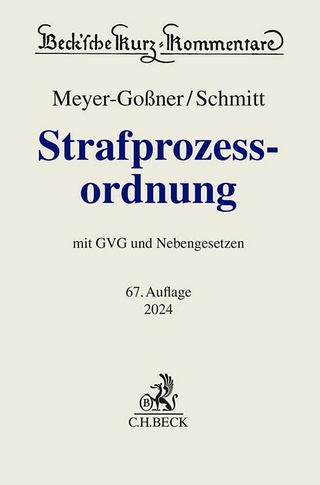
Rethinking Self-Defence
Hart Publishing (Verlag)
978-1-5099-4563-4 (ISBN)
T Markus Funk is the Firmwide Chair of Perkins Coie’s White Collar & Investigations Practice.
1. Setting the Stage
2. Developing the ‘Value-Based Model’ of Self-Defence
I. Early Observers of the ‘Ancient Right’ of Self-Defence
II. An Introduction to Th inking of Values as Decision-Grounds
III. The Orthodox View: ‘Two Principles in Tension’ (Autonomy of the Defender v Autonomy of the Attacker)
IV. Advancing the Debate Th rough a More Value-Centric Dialogue – An Introduction to (and Preliminary Defence of) Seven Proposed Value-Based Decision-Grounds
A. Value #1: Reducing Overall Societal Violence by Protecting the State’s Collective ‘Monopoly on Force’
B. Value #2: Protecting the Attacker’s Individual (Presumptive) Right to Life
C. Value #3: Maintaining the Equal Standing between People
D. Value #4: Protecting the Defender’s Autonomy
E. Value #5: Ensuring the Primacy of the Legal Process
F. Value #6: Maintaining the Legitimacy of the Legal Order
G. Value #7: Deterring (Potential) Attackers
V. The Challenging Act of Balancing the Competing Values
A. The Value-Based Model and the ‘Forfeiture’ of Rights
B. Considering Alternative Value-Accommodation Methods
3. The Scholarly Community’s Surprising Neglect of Values as Self-Defence Decision-Grounds
I. Protecting the State’s Monopoly on Force (and the Primacy of the Legal Process)
II. Respect for the Attacker’s ‘Right to Life’
III. Protecting Equal Standing Among People
IV. Protecting the Defender’s Autonomy
V. Ensuring the Primacy of the Legal Process
VI. Maintaining the Legitimacy of the Legal Order
VII. Deterrence
VIII. Self-Defence Scholarship’s Treatment of Values as Decision-Grounds
4. The Value-Based Model’s Answer to Common Theoretical (‘Hard Case’) Questions
I. Is Self-Defence a Justification or Excuse (or Neither)? … And Why the Answer Matters
A. Aggressors v Passive Threats v Innocent Bystanders – The Importance of Accurate Labelling
B. Mistakes: External, Internal, and Legal Justification
C. ‘Unreasonable’ Mistakes of Fact
II. When Is Defensive Force ‘Necessary’?
A. Distinguishing Self-Defence from Necessity and Duress
B. The Relationship between Necessity and Imminence
C. Retreat and Avoiding Conflict
III. Proportionality of Defensive Force
A. Rejecting Strict Proportionality and Addressing Excessive Force
B. Deadly Force in Defence of Property
C. Responding to ‘Trivial’ Threats
IV. Necessity, Proportionality, Mistakes, and the European Convention on Human Rights
A. The Current Status of Positive Obligations Imposed by Article 2
B. Article 2 in the Self-Defence Context: Defensive Force Must Be ‘Absolutely Necessary’
C. Article 2 in the Self-Defence Context: ‘Strict Proportionality’ Required
D. Article 2 and Deadly Force in Defence of Property
E. Article 2 and Mistakes
V. Application of the Value-Based Model to Other Challenging Cases
A. Innocent Attackers – The ‘Standard’ Case
B. Special Rules for ‘Attacks’ on the Police?
5. Examining German Law’s Treatment of Self-Defence from a Value-Centric Perspective
I. Putting Germany’s Self-Defence Law in Context
II. An Introduction to Self-Defence in Germany
A. The Theoretical Foundations of Self-Defence in Germany
B. Understanding the Arrival and Impact of ‘Socio-Ethical’ Limitations on Defensive Force
III. Subjective or Objective Standard as to Justificatory Circumstances?
A. Mistakes of Fact
B. Unknowingly Justified Defenders
IV. The Attack
A. What Interests Can Be Defended?
B. Need the Attacker’s Conduct Be Criminal?
C. Special Rules for ‘Attacks’ on the Police?
D. Can Passive Conduct Constitute an ‘Attack’?
E. Imminence
F. A New Definition of ‘Attack’?
V. Defensive Conduct
A. Necessity
B. Proportionality and Excessive Force
C. Duty to Retreat and Avoid Conflict
D. Intentionally Provoked Attacks and Other Blameworthy Conduct on the Part of Defenders
VI. Evaluating Germany’s Self-Defence Law from a Value-Centric Perspective
6. Examining the US Law’s Treatment of Self-Defence from a Value-Centric Perspective
I. Putting US Self-Defence Law in Context
II. Subjective or Objective Standard as to the Justificatory Circumstances
A. Mistakes of Fact
B. Unknowingly Justified Defenders
III. The Attack
A. What Interests Can Be Defended?
B. Need the Attacker’s Conduct Be Criminal?
C. Special Rules for Attacks on the Police?
D. Can Passive Conduct Constitute an ‘Attack’?
E. Imminence
F. Necessity
G. Proportionality and Excessive Force
H. Duty to Retreat
I. Duty to Avoid Conflict
J. Intentionally Provoked Attacks and Other Blameworthy Conduct on the Part of the Defender
IV. Evaluating US Self-Defence Law from a Value-Centric Perspective
7. Examining the English Law’s Treatment of Self-Defence from a Value-Centric Perspective
I. Putting England’s Law of Self-Defence in Context
II. Subjective or Objective Standard as to the Justificatory Circumstances?
A. Mistakes of Fact
B. Unknowingly Justified Defenders
III. The Attack
A. What Can Be Defended?
B. Need the Attacker’s Conduct Be Criminal?
C. Special Rules for ‘Attacks’ by the Police?
D. Can Passive Conduct Constitute an ‘Attack’?
E. Imminence
IV. Defensive Conduct
A. Necessity
B. Proportionality and Excessive Force
C. Duty to Retreat and Avoid Conflict
D. Intentionally Provoked Attacks and Other Blameworthy Conduct on the Part of the Defender
V. Evaluating England’s Self-Defence Law from a Value-Centric Perspective
8. Parting Observations
| Erscheinungsdatum | 29.07.2022 |
|---|---|
| Verlagsort | Oxford |
| Sprache | englisch |
| Maße | 156 x 234 mm |
| Themenwelt | Recht / Steuern ► EU / Internationales Recht |
| Recht / Steuern ► Strafrecht ► Strafverfahrensrecht | |
| ISBN-10 | 1-5099-4563-6 / 1509945636 |
| ISBN-13 | 978-1-5099-4563-4 / 9781509945634 |
| Zustand | Neuware |
| Haben Sie eine Frage zum Produkt? |
aus dem Bereich


